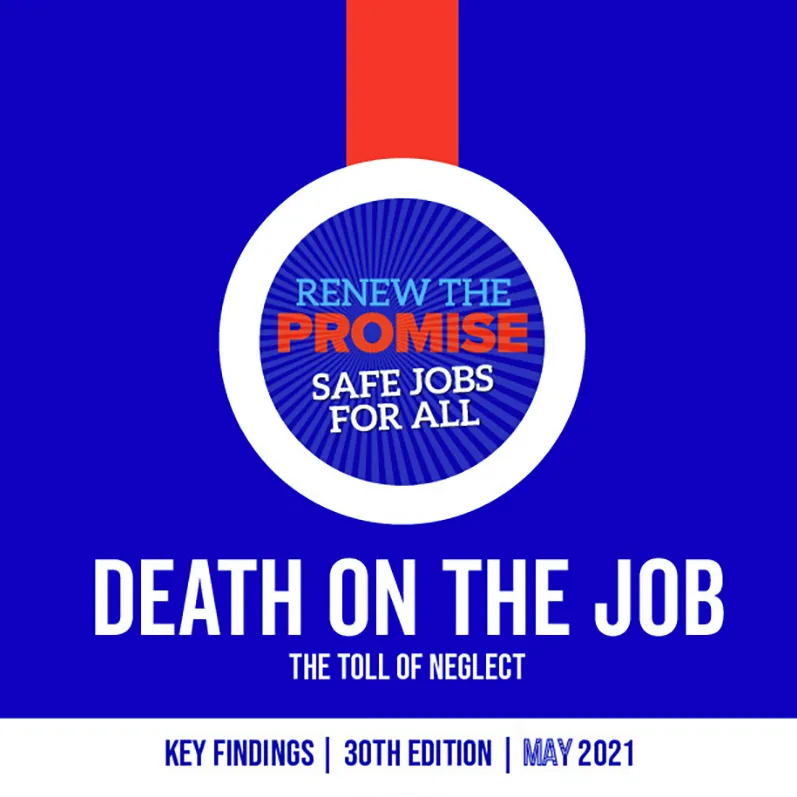New Report Names Nevada 13th Safest State for Workers

(Las Vegas, Nevada) – According to a new report released today by the AFL-CIO, Nevada had the 13th lowest rate of workplace deaths in the country in 2019. This analysis, based on data from the Bureau of Labor Statistics, shows that 40 Nevada workers lost their lives due to on-the-job injuries, resulting in 2.8 deaths per hundred thousand workers.
Nationally in 2019, 5,333 working people were killed on the job and an estimated 95,000 died from occupational diseases. Each and every day, on average, 275 U.S. workers die from hazardous working conditions. The overall rate of fatal job injuries in 2019 was 3.5 per 100,000.
“This year’s report is yet another reminder of the dangers facing working people in Nevada every single day. Now with COVID-19, it’s more important than ever to protect working people,” said Rusty McAllister, Executive Secretary-Treasurer of the Nevada State AFL-CIO. “Nevada’s workers deserve better. We have a right to a safe workplace and a voice on the job. What’s more, we deserve leaders in Carson City and Washington who will stand up for those rights. We are working to champion state legislation that protects workers on the job, particularly as we continue to weather COVID-19. It’s time for a change, and working people are joining together to secure the economic rights and dignity that we’ve earned.”
“This past year has marked a time of immense grief and loss in which we have witnessed so many deaths, illness and injury of our brothers and sisters in labor. This report is a solemn reminder of how much work we have yet to do to protect them, and renews our fight to secure workplace protections both at the state and federal levels,” said Beverly Williams, Secretary-Treasurer of the Southern Nevada Central Labor Council. “No worker should go to work knowing that they may face loss of life or limb. We will not rest as a movement until every Nevadan, and every American can feel safe at work!”
“The COVID-19 pandemic certainly exposed weaknesses in federal and state workforce protections and in some employers’ capabilities to ensure workers are protected on the job so commerce can thrive. Workers were told by some employers initially not to wear a mask because it frightened the customer or patient; workers were told to bring their own PPE to work. Workers who were categorized as ‘essential’, who contracted COVID and subsequently had to use their own time off to recover. Workers who are still not yet back to work. Workers who didn’t recover. Impacts like these have a real human cost,” said Mike Pilcher, President of the Northern Nevada Central Labor Council. “The structural failures that have prevented workers from organizing in their workplaces are nothing more than debris that hinders safer working conditions and a safe, strong economy. The PRO Act will ensure safer working conditions by having more voices on the job. A stronger, healthier, and more stable economy will be the result. Building Back Better means Building Back Safer — for all of us.”
The report, titled “Death on the Job: The Toll of Neglect,” marks the 30th year the AFL-CIO has produced its findings on the state of safety and health protections for workers within the United States.
Other report highlights show that Latino workers are at increased risk of work-related deaths, with a fatality rate of 4.2 per 100,000 workers, a sharp increase from recent years. Black workers are at an increased risk of work-related deaths, with a job fatality rate of 3.6 per 100,000 workers. In 2019, 634 Black workers died— the highest number in more than two decades. Workers 65 or older have nearly three times the risk of dying on the job than all workers, with a fatality rate of 9.4 per 100,000 workers in 2019.
Fifty years ago on April 28, the Occupational Safety and Health Act went into effect, promising every worker the right to a safe job. The law was won in 1970 because of the tireless efforts of the labor movement and allies, who drew major attention to work-related deaths, disease, and injuries, organized for safer working conditions, and demanded action from their government.
But today, due in part to the irresponsible anti-workers policies of the previous administration, OSHA’s meager resources have kept declining. Federal OSHA now has only 774 safety and health inspectors and state OSHA plans have a combined 1,024 inspectors—near the lowest total number of OSHA inspectors since the creation of the agency. This is equivalent to one inspector for every 82,881 workers.
